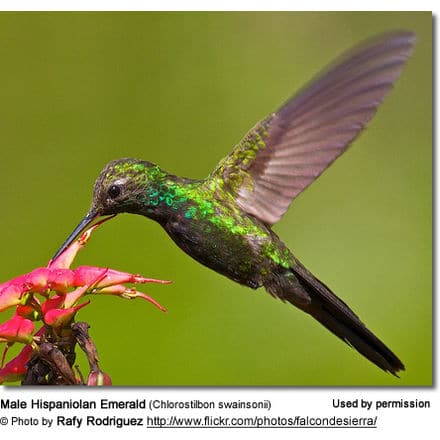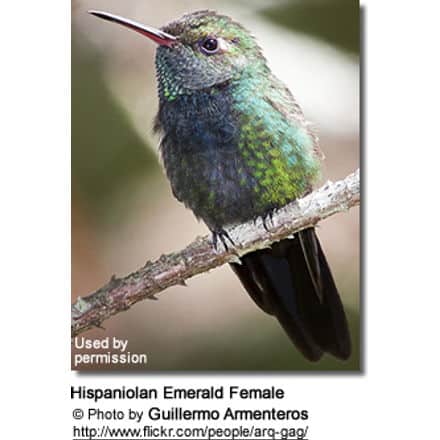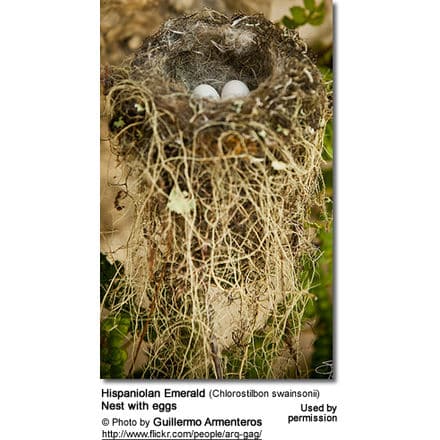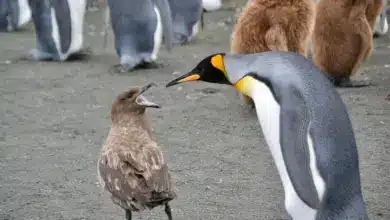Hispaniolan Emeralds
The Hispaniolan Emeralds (Chlorostilbon swainsonii) is a tiny hummingbird that occurs naturally on Hispaniola – a major island in the Caribbean that is separated in the two sovereign states of the Dominican Republic and Haiti. This island is located between Cuba to the west and Puerto Rico to the east.
Habitat
The Hispaniolan Emerald is mostly found at higher elevations, especially in broadleaf and other forested habitats. They mostly remain between 200 – 1,500 m (600 – 5,000 ft) – although they may move to lower altitudes for the winter (between September and December).
They inhabit moist forests, shade coffee plantations in mountains, hills, karst (landscape formed by the dissolution of soluble rocks) and clearings.
Hummingbird Resources
- Hummingbird Information
- Hummingbird Amazing Facts
- Attracting Hummingbirds to Your Garden
- Hummingbird Species
- Feeding Hummingbirds

Alternate (Global) Names
It is locally known as Zumbador Mediano, in reference to the fact that the Hispaniolan Emerald is sized between the larger Antillean Mango (Anthracothorax dominicus) and the smaller Vervain Hummingbird (Mellisuga minima).
Czech: Kolibrík haitský, kolib?ík haitský … Danish: Hispaniolasmaragd … Dutch: Swainsons Smaragdkolibrie, Swainson-smaragdkolibrie … German: Hispaniolansmaragdkolibri, Swainson Kolibri, Swainsonkolibr … Spanish: Esmeralda de la Española, Esmeralda Dominicana, Zumbador Esmeralda, Zumbador Mediano … Finnish: Haitinsmaragdikolibri … French: Émeraude d’Hispaniola, Émeraude élégante … Haitian Creole French: Wanga-nègès mòn … Italian: Colibrì smeraldo di Hispaniola, Smeraldo di Hispaniola … Japanese: kuromonhimeemerarudohachidori … Norwegian: Svartbrystsmaragd … Polish: zlocik obrozny, z?ocik obro?ny … Russian: ????????? ?????????? ??????? … Slovak: smaragdovec náprsenkový …. Swedish: Hispaniolasmaragd

Description:
The Hispaniolan Emeralds average 10.5 cm or 4 inches in length (from head to the tip of the tail) and weigh about 3.75 g or 0.13 oz. It has a straight bill.
Adult Male: The plumage is mostly green, with a dull black chest spot and a deeply forked tail.
Adult Female: The plumage is a dull grey with metallic green sides. She has white tail tips and a conspicuous white post-ocular (eye) spot.
Voice
Their calls are described as sharp, metallic tics.
Status
The Hispaniolan Emerald is generally common in the highlands of the Dominican Republic, but its numbers have been declining in the poverty-stricken Haiti due to forest destruction.


Nesting / Breeding
Hummingbirds are solitary in all aspects of life other than breeding, and the male’s only involvement in the reproductive process is the actual mating with the female. They neither live nor migrate in flocks; and there is no pair bond for this species. Males court females by flying in a U-shaped pattern in front of them. He will separate from the female immediately after copulation. One male may mate with several females. In all likelihood, the female will also mate with several males. The males do not participate in choosing the nest location, building the nest or raising the chicks.
The female Hispaniolan Emerald is responsible for building the cup-shaped nest out of plant fibers woven together and green moss on the outside for camouflage in a protected location in a shrub, bush or tree about 1 – 10 m (3 – 33 feet) above the ground. She lines the nest with soft plant fibers, animal hair and feather down, and strengthens the structure with spider webbing and other sticky material, giving it an elastic quality to allow it to stretch to double its size as the chicks grow and need more room. The nest is typically found on a low, thin horizontal branch.
The average clutch consists of two white eggs, which she incubates alone, while the male defends his territory and the flowers he feeds on. The young are born blind, immobile and without any down.
The female alone protects and feeds the chicks with regurgitated food (mostly partially-digested insects since nectar is an insufficient source of protein for the growing chicks). The female pushes the food down the chicks’ throats with her long bill directly into their stomachs.
As is the case with other hummingbird species, the chicks are brooded only the first week or two, and left alone even on cooler nights after about 12 days – probably due to the small nest size. The chicks leave the nest when they are about 20 days old.

Diet / Feeding
The Hispaniolan Emeralds primarily feed on nectar taken from a variety of brightly colored, scented small flowers of trees, herbs, shrubs and epiphytes. They favor flowers with the highest sugar content (often red-colored and tubular-shaped) and seek out, and aggressively protect, those areas containing flowers with high energy nectar.



